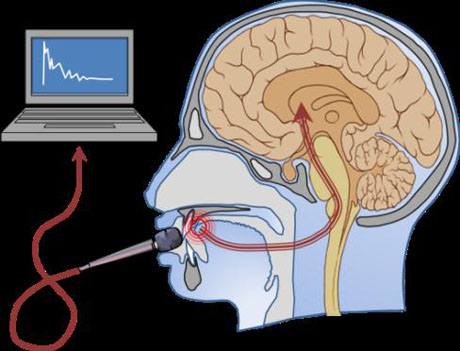
IMAGE: Acoustic tribology diagram via NIZO.
First, drink some black coffee. Next, rub your tongue against the roof of your mouth. It should feel a little rough, like very fine sandpaper: the tiny bumps on your tongue, called papillae, are raised just enough to create friction against your palate.
If you now add cream to your coffee and try again, the sensation should be much smoother — almost velvety. A layer of fat and mucous is now coating your tongue, providing lubrication and preventing friction.
What you have just done was, until very recently, the most accurate method for evaluating the oral perception of fat — the precise degree of tongue-coating creaminess in milk, mayonnaise, or chocolate pudding.
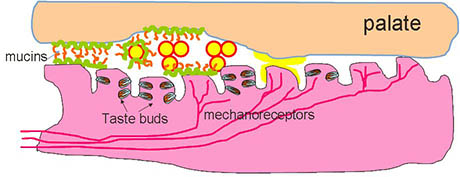
IMAGE: Diagram showing the effect of fatty emulsions on the touch receptors in the tongue’s papillae, via NIZO.
In the worlds of both taste research and product development, fat is an unsolved problem. Scientists are still trying to determine exactly how the human sensory system perceives fat; last year, researchers at Washington University School of Medicine in St. Louis were the first to find a specific taste receptor for fat, but most experts agree that people identify high-fat foods in large part by texture.
Meanwhile, for food giants such as Nestle and Unilever, formulating low fat or fat-free yogurts, cheese spreads, and ice creams that somehow still seem creamy and rich is something of a holy grail.
Until now, however, a company seeking to test the mouthfeel of its new fat-free cheesecake dessert has had two not very satisfactory options: hiring humans to repeat the rubbing experiment you undertook at the start of this post, except with cheesecake dessert, and then comparing their reported perceptions, or else simulating that experiment in a friction-measuring device that uses an analogue human tongue (often from a pig, though a bumpy, moulded silicone surface is sometimes used instead).
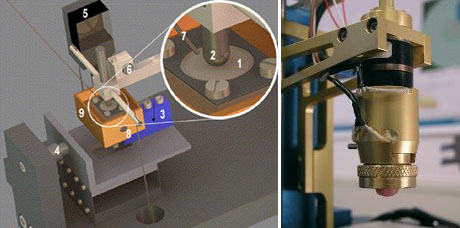
IMAGE: Tribometers measure the amount of friction as two surfaces rub together. The photograph on the right (via NIZO) shows a close-up of a pig’s tongue in the tribometer head. The schematic diagram on the left comes from a paper authored by scientists at a Nestlé Research Centre in Switzerland.
The problems with both methods are several and obvious. Human beings are expensive, time-consuming, variable, and imprecise — oral sensory perception can be affected by mood, previous meals, humidity levels, and even the earlier application of lotions and moisturizer to other parts of the body.
Meanwhile, measurements made using a machine that rubs cheesecake against a pig’s tongue are microscopically detailed, quantitative rather than qualitative, and much more easily controlled against external factors — yet, unsurprisingly, they frequently do not end up correlating very well to human sensory perception. Given these limitations on innovation, it is perhaps no wonder that fat-free products still generally disappoint.
However, in a paper to be published in June 2013 in the journal Food Hydrocolloids, scientist George A. Van Aken of NIZO, a Dutch food research company, reveals a new method of measuring mouthfeel: the wonderfully named “acoustic tribology.” Van Aken took a tiny contact microphone, packed it in polyethylene to keep it dry, and secured it behind a test subject’s upper front incisor teeth in order to record the acoustic signal produced by the varying vibrations of their papillae as their tongue rubbed against their palate.
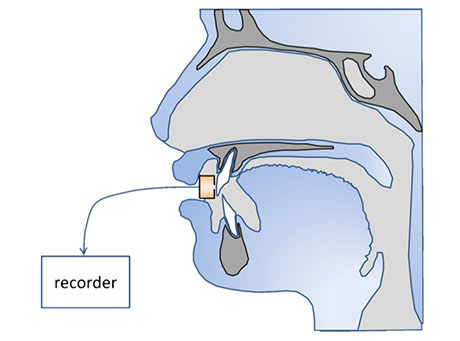
IMAGE: Diagram showing Van Aken’s experimental acoustic tribology set up, from his forthcoming paper “Acoustic emission measurement of rubbing and tapping contacts of skin and tongue surfaces in relation to tactile perception.”
In short, Van Aken’s device means that we can now listen to what our tongues feel.
The process works by picking up vibrations within tongue tissue, which vary depending on the amount of deformation the papillae experience when rubbing against the palate. To return to our initial experiment, you can actually listen to a recording of the feel of black coffee (mp3), and then compare it to the softer sound of the feel of coffee with cream (mp3) or hear them both back-to-back in this NIZO video (wmv) — from sawing wood to depilling a sweater, and back again, interrupted by an occasional higher-pitched pop (apparently, these are caused by the “snapping of salivary films and air bubbles at the papilla surfaces”).
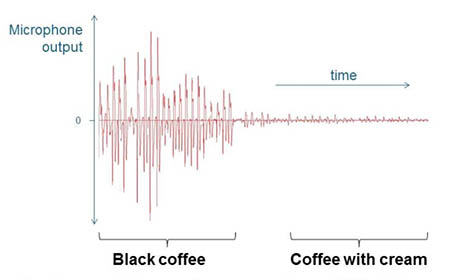
IMAGE: Fat-free black coffee offers the papillae no protective coating, resulting in greater friction, more oscillation within the tissue, and hence a louder acoustic signal. The addition of cream deposits a lubricating layer of fat on the tongue, dampening the friction and thus the vibration-causing movement of the papillae, and resulting in a much softer recording.
Using his new acoustic tribometer, Van Aken tests milk of varying fat content, cream, yogurt, quark, and even “cheese systems,” achieving a much higher resolution picture of mouthfeel than could ever have been achieved using human tissue before. In particular, he finds some intriguing patterns in the acoustic signatures of mouthfeel over time: for example, although skimmed milk initially produces a loud signal (it actually “cleans” fat off the tongue), eventually the sound tapers off, leading Van Aken to speculate that “the tongue surface is smoothened by wear.”
In other words, it’s possible that everything tastes creamy when your tongue is worn out — which perhaps lends weight to the Victorian advice to chew each mouthful one hundred times before swallowing.
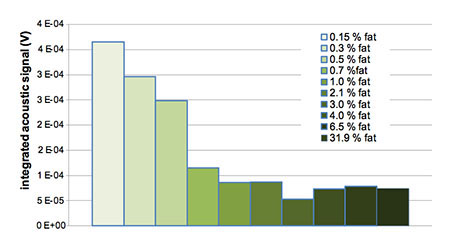
IMAGE: Acoustic signals of milk samples with increasing fat content, potentially suggesting that optimum creaminess occurs at 3% fat content. Diagram from Van Aken’s forthcoming paper “Acoustic emission measurement of rubbing and tapping contacts of skin and tongue surfaces in relation to tactile perception.”
Van Aken is, no doubt correctly, excited at the opportunities his system offers to food scientists trying to engineer creamy fat-free versions of everything. For me, however, the synaesthetic pleasures of hearing mouthfeel remind me of psychologist Charles Spence’s fascinating work on crossmodal interactions between the senses, including the IgNobel award-winning finding that Pringles actually taste crispier when your consumption is accompanied by an amplified recording of in-mouth Pringle crunching. Perhaps Van Aken’s device will enable us to bypass the food scientists and their fat-free alternatives altogether, and instead add the sensory equivalent of cream to a skim latte through a smooth mouthfeel recording, available for 99p on iTunes…

